The scale of the destruction was unimaginable. Thousands of people died a terrible death. The strongest earthquake in Western Europe in modern times
In 1755, All Saints' Day fell on a Saturday. Everyone agrees that the morning of that November day was beautiful. The crisp air, blue sky and sunshine announced that the good weather that last month brought the Lisboners would continue and the inhabitants would enjoy the Indian summer, which is still one of the charms of autumn Lisbon to this day.
Old Testament cataclysm
Residents later recalled that shortly after the church bells rang 9:30 AM, there was a deep, rumbling sound that resembled distant thunder. Some have compared it to the sound of heavy carts racing through the streets. The sound was merely the snare drum that preceded the strongest earthquake to hit Western Europe in modern times . Three violent shocks, interspersed with short pauses, knocked two-thirds of Lisbon's buildings to pieces, and they collapsed with a deafening crash. A six-meter tsunami wave broke deep into the Tagus riverbed, capsizing ships and kidnapping survivors from the mainland, depriving them of their chance to rescue.
A massive fire broke out in the ruins that raged for six days. It was as bright as day in the burning city at night. Earth, water, fire:the cataclysm resembled the wrath of God in the Old Testament. A natural disaster slashed Lisbon's wings after a half-century period of realizing lofty ambitions financed with Brazilian gold. The long, slow reconstruction was to change the face of the city center forever. These seven tragic minutes also shook Europe as it faced weighty questions about God's intentions and the importance of science.
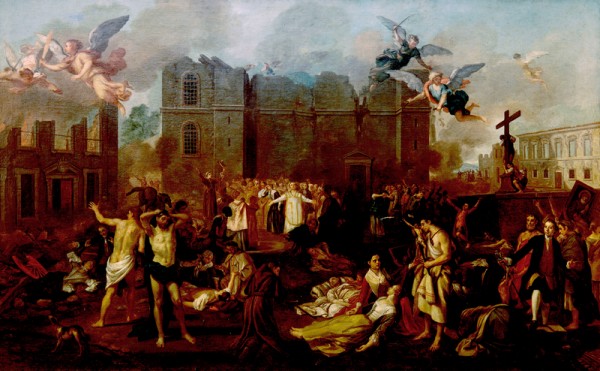
The 1755 earthquake was the strongest. Its epicenter was under the seabed
Earthquakes were nothing new to the Lisboners. In about 400 years, the capital city was hit by as many as 15 such cataclysms, and 3 of them - in the years 1356, 1531 and 1597 - caused serious damage. The quake of 1755 was the strongest, however. Its epicenter was below the seabed at a distance of 250 kilometers southwest of the city. Under the influence of the movements of tectonic plates, the sand and gravel ground under some of the oldest districts of Lisbon shook. The stone and wood buildings crumbled like houses of cards. The narrow streets of Lisbon, which for centuries had not been marked out according to some top-down, deliberate plan, but grew without order and composition, depending on the needs and possibilities, turned into death traps.
"I stood among the bodies of the dead"
The scale of the destruction was unimaginable. Thousands of people have died horrific deaths:under the rubble of houses, as a result of suffocation, in flames or under water. The survivors told terrifying stories. Their shocking relationships resemble the scripts of contemporary catastrophe films.
Father Manoel Portal lay under the rubble of the Convento da Congregaçao do Oratório, with his leg trapped under the stone part of the wall. Luckily, two men got him out of the rubble. The rescued monk limped into the street "with his eyes flooded with blood." The sight he saw there chilled his blood in his veins. "As soon as I left the entrance gate, I stood among the bodies of the dead." , he recalled in a book written a year later entitled A story about the destruction of the city of Lisbon as a result of ą scared ż aj ą all three ę the earth and po ż aru that rotate ł to dust and ashes ł the best ą and the greatest ę ksz ą cz part it was bad ę of dream city .
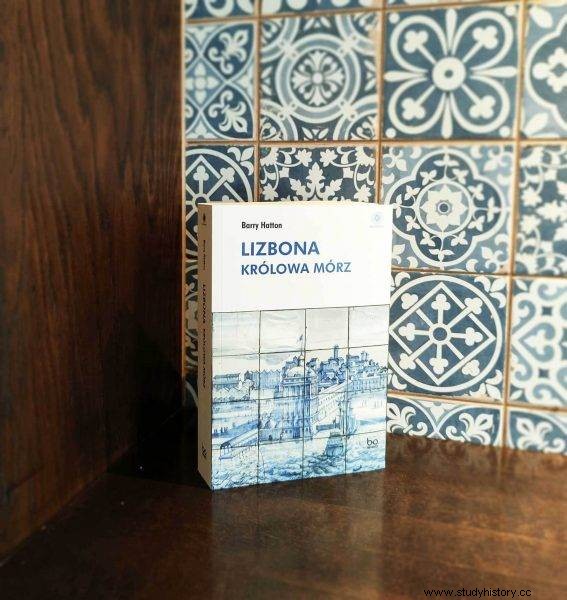
The text is an excerpt from Barry Hatton's book "Lisbon. Królowa Mórz ”, which has just been released by the Publishing House of the Jagiellonian University.
Thomas Chase, an Englishman living in Lisbon who was on the top floor of the building when it collapsed under his feet, fell from the fourth floor. Despite the fact that the man was seriously injured - he had several fractures and sprains, numerous wounds and bruises - he managed to crawl out from under the rubble on his own. Survivors he met in the street panicked as the air turned gray. "The people, covered in gray dust, prayed earnestly, and the light was like on a very cloudy day," wrote Chase in a letter he sent home a month after the earthquake.
Witnesses to the apocalypse
Reverend Charles Davy, an Anglican clergyman who was visiting Lisbon, also mentioned "very great clouds of dust and limescale," presumably because no rain had fallen in the city for weeks. The clouds of dust that obscured the sun were so dense that the priest gasped for ten minutes with the utmost difficulty and trembled with terror at the thought of witnessing an apocalypse.
Survivors who wandered aimlessly around under the influence of shock were showered with grayish dust, as were those who on September 11, 2001, found themselves near the site of the terrorist attacks in New York. Bloodied people wandered among the ruins in search of their loved ones. The children were screaming. Howling dogs and pitifully roaring mules were dying, left to their fate.
According to the Reverend Richard Goddard, the parish priest of Lacock Abbey in the South West of England, who, in a state of utter bewilderment, stumbled across the streets of the city that trembled with the aftershocks, the superstitious inhabitants of Lisbon were very frightened. All Saints' Day is one of the most important Catholic holidays during which the faithful pay tribute to the saints. The pastor wrote:
No words can express the misery of my position at that moment, as I stood in almost complete darkness in the city collapsing into rubble , among the crowds screaming and begging for people's mercy, when we all expected it at any moment we are consumed by the earth shaken by violent convulsions.
Death Trap
Under the influence of the cataclysm, people fell into a religious rapture. They knelt in the streets and prayed; they kissed the crosses and raised them to heaven. Reverend Goddard recalled that when he came across a group of survivors, they forced him to convert immediately to Catholicism. The clergyman was afraid that an over hundred "fat" would kill him if he refused to change his religion. Later, these people pounced on him and “almost choked me with their embraces; several priests fell to the ground in front of me to hug their knees and kiss the feet of their newly converted fellow believer. "
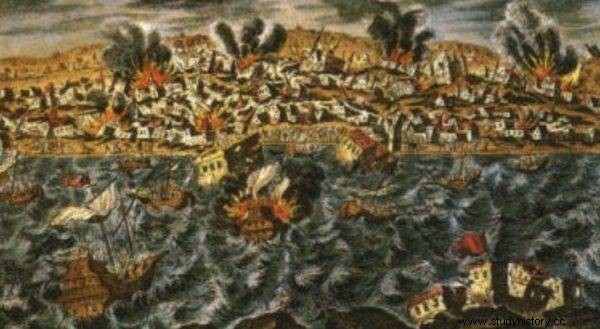
The tsunami that broke into the city was so powerful that it damaged North Africa as well.
According to the pastor, they were convinced that if they converted someone to their faith, they would redeem some of their sins and avoid further suffering . But their ordeal is not over yet. Some desperate Lisboners, fleeing death under the collapsing rubble and the traps of blocked streets, headed towards the nearest open area:Terreiro do Paço, a vast square on the Tagus, next to the royal palace. As it turned out, they made a terrible choice.
Soon the water in the river and in the Straw Sea began to churn and foam, snapping anchor chains and kidnapping ships like toys. Davy, referring to the "rippling and rising of the waters," added, "in an instant, a great mass of water appeared nearby, rising up like a mountain. In splashes of foam, she crashed ashore with such force that we all rushed to flee immediately and ran as hard as we could to save our lives ”. Some ships "turned over and thrashed like in a violent storm" while others "spun at breakneck speed; several large boats capsized with the keel up ". The massive stone wharf and the people who were looking for a safe haven on it, "were kidnapped and swallowed up by a giant whirlpool , and they are gone forever. ”
The disaster of water and fire
José Moreira de Mendonça, who also survived the earthquake, recalled that when the tsunami rushed up the Tagus, it exposed its bottom, and on its return it carried people away and dragged them into the rushing current of the river. Davy noted that when, just outside the city, people were "riding on horseback along the wide road that leads to Belém and one side of which opens onto the river, the waves came so fast that they had to gallop towards the higher ground to avoid being swept away by the water. ". The tsunami that burst deep into the city as far as Rossio Square was so powerful that it damaged North Africa as well, and after about ten hours it reached the Caribbean.
Chase said the people who had survived the disaster and gathered in Terreiro do Paço were convinced that the day of doomsday had arrived. They prayed, pressed their crucifixes to their chests, and cried out "Mercy! after each resurgence! … Voices filled with unimaginable pain ”. Davy pointed out that social status suddenly ceased to have any meaning because "people of both sexes, status and position, among which I saw some of the chief canons of the patriarchal church, in their purple robes and rochet," prayed on their knees, "hitting breasts and incessantly calling: Misericordia meu Dios! (sic!) ”(“ Have mercy, my God! ”).
There were also "half-clothed ladies, some of them without footwear" in the crowd. Chase recorded that at 2:00 p.m. the dust began settling and the sun showed. He then noticed that the royal palace was on fire. Candles, lamps and fireplaces in houses and churches all over Lisbon triggered the third cataclysm of the day. A strong northeast breeze, typical of this windy Atlantic harbor, blew the flames out, causing firestorms that consumed the wooden houses in no time. Most of the survivors fled to the river or to surrounding villages, and only a handful of people capable and willing to put out the flames remained in the city.
"The whole city was on fire"
Davy recalled that the city "was burning simultaneously in at least a hundred different places and was burning for six days without a break and no one made the slightest attempt to contain the flames. Mendonça wrote in his account that the fire spread from the riverside district of Ribeira to Rossio and Bairro Alto, and then to Alfama. In his opinion, a fire engulfed a third of the city, including the wealthiest and most densely populated districts. After dusk, Davy noted, "the whole city was on fire, so bright I could read in their glare without difficulty."
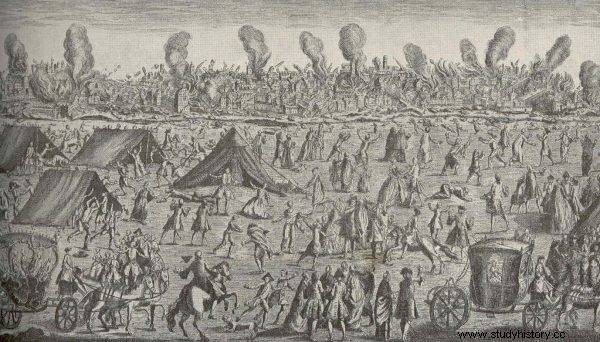
The whole city was on fire
Chase stated that the fire was spreading "with unrestrained speed." Both sides of the rich Rua Nova were on fire. It was enough to draw toxic smoke into the lungs several times to lose a life. Chase saw a lot of bodies lying in the streets that night and heard cries for help. The fire consumed most of the earthquake-resistant buildings in the heart of one of Europe's greatest cities.
Balance of losses
The fire sealed the fate of Lisbon's treasures. If the buildings only collapsed, something could be saved. The flames, however, annihilated almost everything that was not destroyed by the earthquake. Mendonça in his book Historia Universal dos Terremotos ( The Universal History of Earthquakes ) lists 3 dozen churches and about 60 monasteries that were completely destroyed that day. Even today, when the Portuguese want to say that some dramatic event took place, they often use the expression Cai o Carmo e a Trindade (Carmo and Trindade fall over). It alludes to two important monasteries in Lisbon that were destroyed during the earthquake.
Thousands of rare books were kept in the libraries of all the monasteries that had fallen into disrepair. In addition, Lisbon lost six hospitals including the magnificent Todos os Santos Hospital, Royal Palace, Opera House, Royal Archives, Royal Arsenal, Archbishop's Palace, House of India and Customs . In the library of the royal palace, which was completely burned down, there were tens of thousands of books. The walls and floors of the palace were decorated with tapestries and Persian rugs. Also, priceless documentation from the time of territorial expansion has been lost.
British historian T.D. Kendrick compiled a list of irretrievably lost priceless objects and works of art from only one palace in Lisbon, which belonged to the Marquis of Louriçal, to give us some idea of the enormous damage Lisbon suffered as a result of the earthquake. Among the destroyed treasures there were some 200 paintings, including works by Titian, Correggio and Rubens , 18,000 printed books, 1,000 manuscripts, including a history written by himself by Emperor Charles V, a rich collection of maps of lands and seas with marked routes of Portuguese exploratory expeditions.
Post-disaster landscape
When the fire was extinguished, Lisbon looked like a city after bombing. Davy wrote:
I assure you that this vast and prosperous city is now nothing more than just a great pile of rubble; that nowadays the rich are no different to be nothing from the poor; thousands of families that just the day before they lived carelessly and in abundance, now, scattered, they wander among the fields, deprived of all comforts and hopes of improving their fortunes.
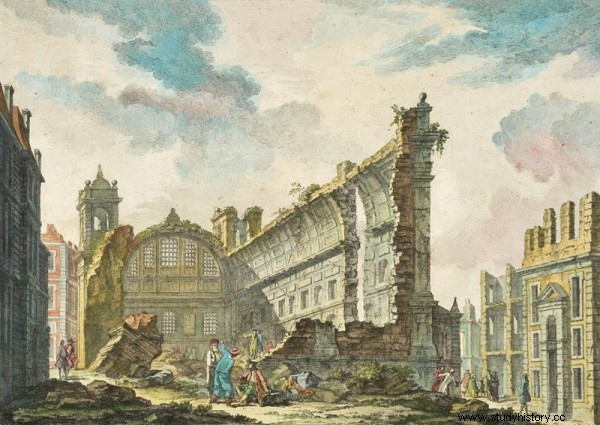
When the fire was extinguished Lisbon looked like a city after bombing.
The estimates of the size of human losses vary considerably. Some historians believe they could have been as high as 60,000 but according to more modest - and widely accepted - estimates between 10,000 and 20,000 people died . At that time, the city had over 200,000 inhabitants. Two-thirds of the houses in Lisbon were uninhabitable.
When the disaster struck the city, the royal family was in their country residence in Belém and was not harmed. But the papal nuncio in Lisbon, Filippo Acciaiuoli, wrote to his brother that the king had fled the palace in a nightgown. For several days, until the tent was found, the ruler and the entire royal family slept in the carriage. The tragedy so shocked King Joseph I that since then he lived in wooden and canvas tents to avoid death under the rubble of a stone building and only returned to the city center after six years. The Lisbon nobility were also forced to live in harsh conditions. Almost 40 of the capital's palaces fell into ruins. The aristocrats, without a roof over their heads, collected pieces of wood and sailcloth in the river yards, from which they built makeshift shelters.
"Lisbon is a pile of rubble"
Acciaiuoli noticed that those who survived were deeply shocked. He stated that "in short, terror and misery reign here, and Lisbon is a pile of rubble." Davy wrote that the earthquake "turned a once flourishing, wealthy and populous city into an image of extreme poverty and despair" . The most visible scar left by that week, when the legacy of six centuries was wiped out and all the treasures of Lisbon irretrievably lost is the Carmelite Monastery.
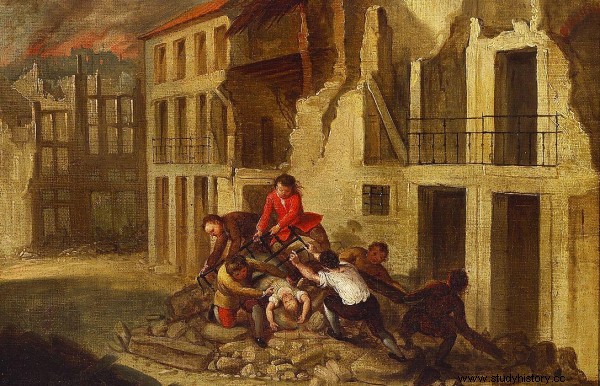
The earthquake "turned a once flourishing, wealthy and populous city into an image of utter misery and despair."
The tragedy of Lisbon echoed widely throughout Europe. She became an inspiration for poems and novels, for philosophical and theological treatises, scientific treatises and works of art. The most eminent minds of the Enlightenment age, such as the German philosopher Immanuel Kant, the French philosopher Jean-Jacques Rousseau and the writer Voltaire, joined the reflection on the meaning and meaning of that earthquake. The English Methodist John Wesley also expressed his opinion on this subject. Was it the finger of God or rather a phenomenon that can be explained scientifically? Why did God choose Lisbon, where the Inquisition was active and where the Portuguese took the word of God to the farthest corners of the world? And why did the tragedy happen on such an important holiday?
The sensational news of the disaster that befell Lisbon caused terror across the continent. Can you feel safe anywhere and be sure that you will avoid a similar fate? The German poet Johann Wolfgang von Goethe called this cataclysm "an event of world importance". In his memoirs we read:"The demon of horror has never spread fear around the world with such speed and power." In January 1756, the German Gazette de Cologne stated that "the earthquake is still on everyone's lips". Elephants and rhinos were no longer the showpieces of Lisbon.
Source:
The text is an excerpt from Barry Hatton's book "Lisbon. Królowa Mórz ”, which has just been published by the Publishing House of the Jagiellonian University.

